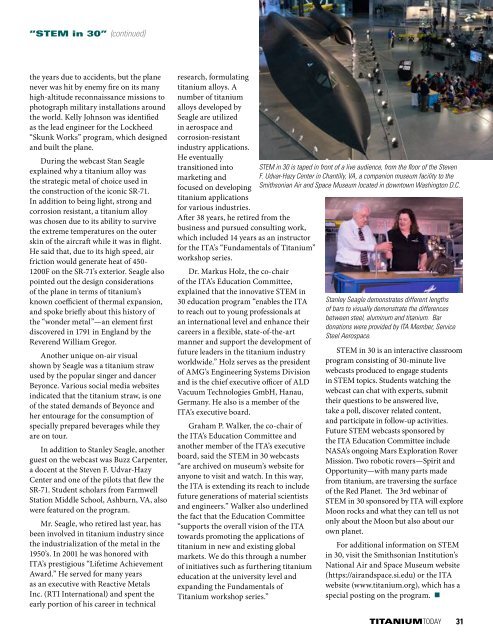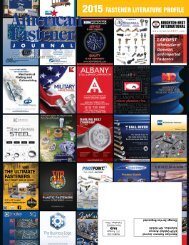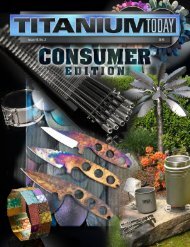100% Positive Material Identification
23mhiW2
23mhiW2
Create successful ePaper yourself
Turn your PDF publications into a flip-book with our unique Google optimized e-Paper software.
“STEM in 30” (continued)<br />
the years due to accidents, but the plane<br />
never was hit by enemy fire on its many<br />
high-altitude reconnaissance missions to<br />
photograph military installations around<br />
the world. Kelly Johnson was identified<br />
as the lead engineer for the Lockheed<br />
“Skunk Works” program, which designed<br />
and built the plane.<br />
During the webcast Stan Seagle<br />
explained why a titanium alloy was<br />
the strategic metal of choice used in<br />
the construction of the iconic SR-71.<br />
In addition to being light, strong and<br />
corrosion resistant, a titanium alloy<br />
was chosen due to its ability to survive<br />
the extreme temperatures on the outer<br />
skin of the aircraft while it was in flight.<br />
He said that, due to its high speed, air<br />
friction would generate heat of 450-<br />
1200F on the SR-71’s exterior. Seagle also<br />
pointed out the design considerations<br />
of the plane in terms of titanium’s<br />
known coefficient of thermal expansion,<br />
and spoke briefly about this history of<br />
the “wonder metal”—an element first<br />
discovered in 1791 in England by the<br />
Reverend William Gregor.<br />
Another unique on-air visual<br />
shown by Seagle was a titanium straw<br />
used by the popular singer and dancer<br />
Beyonce. Various social media websites<br />
indicated that the titanium straw, is one<br />
of the stated demands of Beyonce and<br />
her entourage for the consumption of<br />
specially prepared beverages while they<br />
are on tour.<br />
In addition to Stanley Seagle, another<br />
guest on the webcast was Buzz Carpenter,<br />
a docent at the Steven F. Udvar-Hazy<br />
Center and one of the pilots that flew the<br />
SR-71. Student scholars from Farmwell<br />
Station Middle School, Ashburn, VA, also<br />
were featured on the program.<br />
Mr. Seagle, who retired last year, has<br />
been involved in titanium industry since<br />
the industrialization of the metal in the<br />
1950’s. In 2001 he was honored with<br />
ITA’s prestigious “Lifetime Achievement<br />
Award.” He served for many years<br />
as an executive with Reactive Metals<br />
Inc. (RTI International) and spent the<br />
early portion of his career in technical<br />
research, formulating<br />
titanium alloys. A<br />
number of titanium<br />
alloys developed by<br />
Seagle are utilized<br />
in aerospace and<br />
corrosion-resistant<br />
industry applications.<br />
He eventually<br />
transitioned into STEM in 30 is taped in front of a live audience, from the floor of the Steven<br />
marketing and<br />
F. Udvar-Hazy Center in Chantilly, VA, a companion museum facility to the<br />
focused on developing Smithsonian Air and Space Museum located in downtown Washington D.C.<br />
titanium applications<br />
for various industries.<br />
After 38 years, he retired from the<br />
business and pursued consulting work,<br />
which included 14 years as an instructor<br />
for the ITA’s “Fundamentals of Titanium”<br />
workshop series.<br />
Dr. Markus Holz, the co-chair<br />
of the ITA’s Education Committee,<br />
explained that the innovative STEM in<br />
30 education program “enables the ITA<br />
to reach out to young professionals at<br />
an international level and enhance their<br />
careers in a flexible, state-of-the-art<br />
manner and support the development of<br />
future leaders in the titanium industry<br />
worldwide.” Holz serves as the president<br />
of AMG’s Engineering Systems Division<br />
and is the chief executive officer of ALD<br />
Vacuum Technologies GmbH, Hanau,<br />
Germany. He also is a member of the<br />
ITA’s executive board.<br />
Graham P. Walker, the co-chair of<br />
the ITA’s Education Committee and<br />
another member of the ITA’s executive<br />
board, said the STEM in 30 webcasts<br />
“are archived on museum’s website for<br />
anyone to visit and watch. In this way,<br />
the ITA is extending its reach to include<br />
future generations of material scientists<br />
and engineers.” Walker also underlined<br />
the fact that the Education Committee<br />
“supports the overall vision of the ITA<br />
towards promoting the applications of<br />
titanium in new and existing global<br />
markets. We do this through a number<br />
of initiatives such as furthering titanium<br />
education at the university level and<br />
expanding the Fundamentals of<br />
Titanium workshop series.”<br />
Stanley Seagle demonstrates different lengths<br />
of bars to visually demonstrate the differences<br />
between steel, aluminum and titanium. Bar<br />
donations were provided by ITA Member, Service<br />
Steel Aerospace.<br />
STEM in 30 is an interactive classroom<br />
program consisting of 30-minute live<br />
webcasts produced to engage students<br />
in STEM topics. Students watching the<br />
webcast can chat with experts, submit<br />
their questions to be answered live,<br />
take a poll, discover related content,<br />
and participate in follow-up activities.<br />
Future STEM webcasts sponsored by<br />
the ITA Education Committee include<br />
NASA’s ongoing Mars Exploration Rover<br />
Mission. Two robotic rovers—Spirit and<br />
Opportunity—with many parts made<br />
from titanium, are traversing the surface<br />
of the Red Planet. The 3rd webinar of<br />
STEM in 30 sponsored by ITA will explore<br />
Moon rocks and what they can tell us not<br />
only about the Moon but also about our<br />
own planet.<br />
For additional information on STEM<br />
in 30, visit the Smithsonian Institution’s<br />
National Air and Space Museum website<br />
(https://airandspace.si.edu) or the ITA<br />
website (www.titanium.org), which has a<br />
special posting on the program. •<br />
TITANIUMTODAY 31







